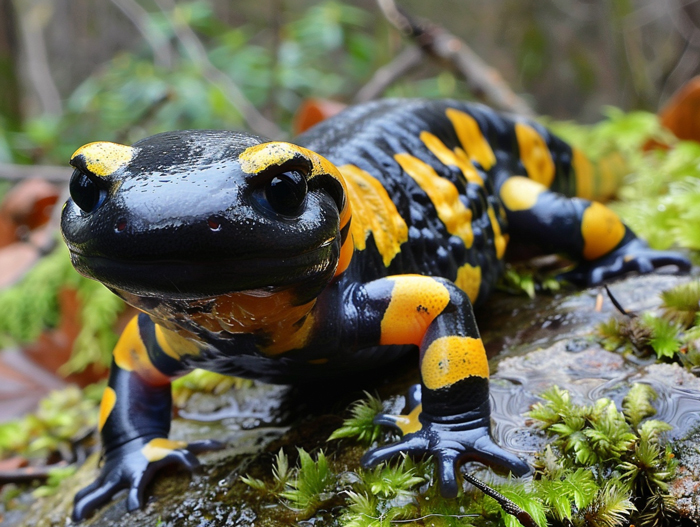Are you curious about where salamanders live? These fascinating creatures can be found in a variety of habitats around the world. From damp forests to freshwater streams, salamanders have adapted to thrive in diverse environments. Whether you’re exploring a woodland area or a mountainous region, you may come across these elusive amphibians. Let’s jump into the different habitats where salamanders make their homes.
Salamanders are known for their preference for moist and cool locations. You’ll often find them hiding under rocks, logs, or leaf litter to stay sheltered from the elements. Some species of salamanders are aquatic, residing in ponds, lakes, or streams. Others prefer the solitude of underground burrows. Understanding the habitats where salamanders live is key to appreciating their importance in the ecosystem.
Key Takeaways
- Salamanders can be found in various habitats such as forests, streams, underground burrows, caves, grasslands, and mountains.
- They prefer moist and cool locations, with some species being aquatic and residing in ponds, lakes, or streams.
- Salamanders adapt to different environments for survival, showcasing resilience and adaptability.
- Threats to salamander habitats include climate change and habitat destruction.
- Terrestrial salamanders thrive in woodland habitats under logs, rocks, or leaf litter.
- Aquatic salamanders inhabit freshwater environments like ponds, streams, lakes, wetlands, and bogs.
Overview of Salamanders’ Habitats

Salamanders, fascinating creatures that they are, can be found in a variety of habitats, each offering unique conditions that these amphibians have adapted to thrive in. Let’s investigate into the diverse habitats where salamanders call home:
- Forests: Salamanders often inhabit damp forests, taking shelter beneath leaf litter or fallen logs. These environments provide the moisture and cover necessary for their survival.
- Streams and Ponds: Many salamander species reside in freshwater environments like streams and ponds. These habitats offer ample access to water for reproduction and hunting.
- Underground Burrows: Some salamanders, like the mole salamander, create intricate underground burrows for protection and to maintain moisture levels essential for their well-being.
- Caves: Certain species of salamanders are adapted to cave environments, where they navigate through the darkness using their keen sense of smell and touch.
- Grasslands: In drier regions, you can find salamanders in grasslands, where they seek out moist areas such as marshes or damp soil to thrive.
- Mountains: High-altitude regions, including mountainous areas, host salamanders that have adapted to the cooler temperatures and rocky terrain of these habitats.
Armed with a better understanding of the diverse habitats where salamanders live, you can truly appreciate the resilience and adaptability of these remarkable amphibians.
| Salamander Fact | Data |
|---|---|
| Total Salamander Species | 800+ |
| Habitats inhabited | Various, including forests, streams, burrows |
| Threats to habitats | Climate change, habitat destruction |
Terrestrial Salamanders

Discover the habitats where terrestrial salamanders thrive:
Woodland Habitats
- Woodland salamanders are found in forests across North America.
- These areas offer moist, shady environments that are ideal for salamanders.
- You can spot them under logs, rocks, or leaf litter, where they seek shelter.
- Some species of salamanders inhabit grasslands.
- These open areas provide different challenges, but salamanders adapt to seek refuge in underground burrows or soil crevices.
- Look out for these fascinating creatures in grassy regions as they go about their daily activities.
Learn more about the diverse environments where salamanders thrive.
Aquatic Salamanders
Aquatic salamanders are a fascinating group of amphibians that thrive in various watery environments. Let’s investigate into their habitats.

Freshwater Habitats
- Ponds: Aquatic salamanders can be found in ponds, where they swim gracefully and hunt for prey.
- Streams: Some species prefer the flowing waters of streams, where they navigate the currents with ease.
- Lakes: In larger bodies of water like lakes, aquatic salamanders adapt to the deeper and calmer environment.
- Wetlands: Marshes are crucial habitats for many aquatic salamanders, offering a mix of shallow water and vegetation cover.
- Bogs: These acidic wetlands are home to specialized species of salamanders that have unique adaptations to thrive in such environments.
Explore the diverse aquatic habitats where these remarkable creatures call home.
Conclusion
Aquatic salamanders are fascinating creatures that have adapted to thrive in various watery environments. From ponds and streams to marshes and bogs, these amphibians display graceful swimming and hunting behaviors. Their ability to survive and flourish in freshwater habitats showcases their remarkable resilience and unique adaptations. Exploring the diverse habitats where salamanders live provides valuable insights into the intricate ecosystems they are a part of. By understanding and appreciating the importance of wetlands as crucial habitats for specialized species of aquatic salamanders, we gain a deeper appreciation for the delicate balance of nature. Next time you encounter a wetland, take a moment to consider the hidden world of salamanders that call it home.

Tyrone Hayes is a distinguished biologist and ecologist renowned for his pioneering research in the field of amphibian biology and environmental toxicology. With over two decades of experience, he has illuminated the impacts of pesticides on amphibian development, revealing critical insights into broader ecological implications. Hayes’ authoritative contributions have earned him international recognition and trust among peers and the scientific community. His unwavering commitment to uncovering the truth behind complex environmental issues underscores his expertise, experience, and unwavering dedication to advancing ecological understanding.
